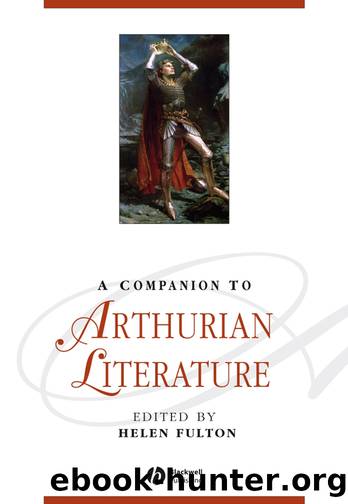A Companion to Arthurian Literature by Fulton Helen;

Author:Fulton, Helen;
Language: eng
Format: epub
Publisher: John Wiley & Sons, Incorporated
Published: 2011-11-20T16:00:00+00:00
The Fallible Gawain of Chivalric Romance
When the Arthurian legend was elaborated in the twelfth century by Chrétien de Troyes and his followers, a new set of literary and cultural values was brought to bear upon the myth. In place of a primary focus on the Round Table knights as warriors brought together by a Brythonic chieftain, the Arthurian fraternity were now reconceptualized as courtier knights with a primary devotion to notions of truth, honor, and the service of ladies (see chapter 11). This change of emphasis would be epitomized in the figure of Sir Lancelot du Lac – a new right-hand man for Arthur whose virtues were conceived less in the heroic terms of early tribal Britain and more in the localized, refined, and courtly terms of Camelot.
As the Arthurian legend was modulated into this new courtly register, the figure of Gawain (French Gauvain) took on new dimensions. In many ways, the character was comfortably assimilated into courtly culture, his heroic stature being translated into prowess in knighthood. At the same time, Gawain became displaced as Arthur’s right-hand man by the dominance of Lancelot and his stature implicitly diminished even as Lancelot’s was augmented. In romances where the chivalry of Lancelot, Perceval, and other knights is celebrated, Gawain’s role is limited to that of supportive or contrastive figure in relation to the protagonist (Busby 1980). We can see an example of this in the Middle English romance Ywain and Gawain – the only extant English translation of a Chrétien romance. Among other themes, the poem addresses the conflict that Sir Ywain experiences in balancing his commitment to knighthood with his devotion to his lady. Although Gawain is presented throughout in a favorable light – he is styled Sir Gawayn, knyght valiant (line 541) and Sir Gawayne the curtayse (line 1420) – he appears as a figure with limited sympathy for Ywain’s dilemma, counseling him to pursue deeds of arms and to resist enfeeblement and enervation by languishing with a lover:
Syr Gawayn did al his mayne
Download
This site does not store any files on its server. We only index and link to content provided by other sites. Please contact the content providers to delete copyright contents if any and email us, we'll remove relevant links or contents immediately.
| Ancient & Classical | Arthurian Romance |
| Beat Generation | Feminist |
| Gothic & Romantic | LGBT |
| Medieval | Modern |
| Modernism | Postmodernism |
| Renaissance | Shakespeare |
| Surrealism | Victorian |
4 3 2 1: A Novel by Paul Auster(11047)
The handmaid's tale by Margaret Atwood(6852)
Giovanni's Room by James Baldwin(5877)
Big Magic: Creative Living Beyond Fear by Elizabeth Gilbert(4723)
Asking the Right Questions: A Guide to Critical Thinking by M. Neil Browne & Stuart M. Keeley(4574)
On Writing A Memoir of the Craft by Stephen King(4213)
Ego Is the Enemy by Ryan Holiday(3991)
Ken Follett - World without end by Ken Follett(3972)
The Body: A Guide for Occupants by Bill Bryson(3800)
Bluets by Maggie Nelson(3709)
Adulting by Kelly Williams Brown(3669)
Guilty Pleasures by Laurell K Hamilton(3586)
Eat That Frog! by Brian Tracy(3514)
White Noise - A Novel by Don DeLillo(3434)
The Poetry of Pablo Neruda by Pablo Neruda(3366)
Alive: The Story of the Andes Survivors by Piers Paul Read(3310)
The Bookshop by Penelope Fitzgerald(3225)
The Book of Joy by Dalai Lama(3217)
Fingerprints of the Gods by Graham Hancock(3212)
